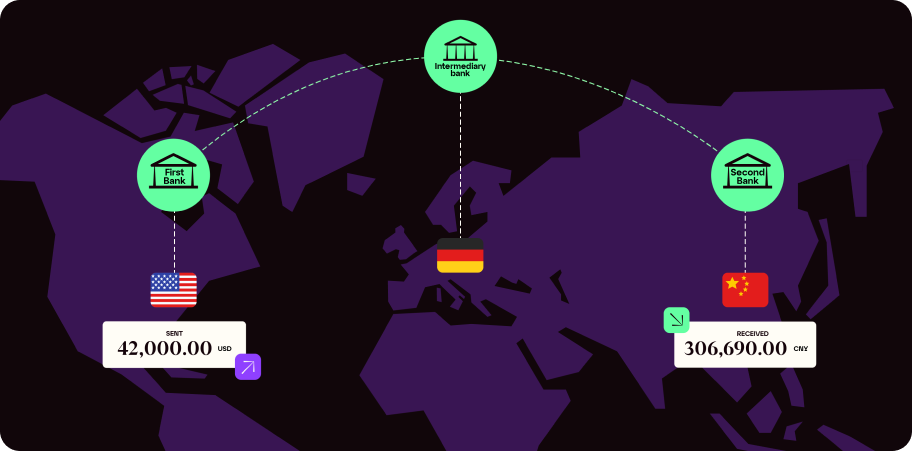Have you ever wondered why your international money transfers take longer than expected? The answer may lie in the role of intermediary banks.
When sending money overseas, it is very often not a direct transfer from one bank to another. Instead, the funds pass through one or more intermediary banks before reaching the recipient's account. These intermediary banks play a crucial role in facilitating cross-border transactions, but their involvement can also lead to delays and additional fees.
Understanding the role of intermediary banks is essential for any company that regularly sends or receives money internationally. In this article, we'll delve into what intermediary banks are, how they operate, and the impact they have on the speed and cost of international transfers.
What is an intermediary bank?
The transfer is much simpler when you’re sending an international wire transfer, and both the sending and receiving bank have an established banking relationship. The two banks have accounts set up that can facilitate the transfer via existing protocols, such as SWIFT.
Intermediary banks act as a go-between for financial institutions in different countries. When the sending and receiving institutions don’t have an existing banking relationship, they’ll use an intermediary bank. The intermediary bank is able to transfer funds between the two banks, and the entire transaction will be completed by the three banks working together.
How do intermediary banks work?
Intermediary banks receive instructions from the sender’s bank and then transfer the funds to the receiver’s bank. Both the sending and the receiving bank must have a relationship with the intermediary bank. In instances where they don’t, an additional intermediary may be involved.
To give an example, let’s say Joe lives in the U.K. and conducts business internationally. He banks with First Bank. He needs to pay a vendor, ABC Company, in the United States. ABC Company banks with Second Bank.

First Bank in the U.K. does not have a relationship with Second Bank in the U.S. Therefore, First Bank will use an intermediary bank. The intermediary bank will have accounts with both First Bank and Second Bank. This relationship is what allows the transaction to occur.
The intermediary bank will rely on SWIFT, the global messaging system used to transfer funds internationally. First Bank will send instructions via SWIFT to the intermediary bank, which will then deposit the funds into Second Bank’s account. Joe doesn’t need to know anything about the intermediary bank: First Bank will handle that for him.
When an intermediary bank is used, it takes more time for the funds to reach their final destination.
What’s the difference between intermediary banks and correspondent banks?
In addition to intermediary banks, the term “correspondent bank” is sometimes used. In some parts of the world, such as the EU, there is no difference between an intermediary bank and a correspondent bank. However, there are some key differences in other parts of the world.
A correspondent bank generally provides services to a bank in another country. Services can include more than international wire transfers. The two banks will enter into an agreement that allows the correspondent bank can also conduct business transactions and gather documents on behalf of the other bank. Correspondent banks are often especially important for smaller banks that may not be able to handle currency exchanges on their own or have limited business relationships with other banks.
In countries that have a distinction between a correspondent bank and an intermediary bank, the intermediary bank operates in a more limited capacity. Its main function is to facilitate international financial transactions.
If the sending and receiving banks don’t have an established relationship, they can use the SWIFT network to find a correspondent bank or intermediary bank.
What fees are associated with intermediary banks?
In addition to taking longer, intermediary banks will assess fees. SWIFT instructions contain a code that identifies who will pay the fees. The codes are as follows:
OUR: The sender pays all the transaction fees
BEN: The receiver pays all transaction fees
SHA: The costs are divided between the sender and the receiver
When the sender pays all transaction fees, the receiver receives the full amount sent. When the receiver pays the fees, they are deducted from the transfer amount.
Intermediary fees range from $15 to $30 per transaction. If the sender needs to transfer $400 and agrees to pay the transaction fees, the total cost could be $430. If the receiver is paying the fees, the amount received would be $370. The fees add up, especially for people and businesses sending a lot of international transfers and even more so if the transaction has to go through multiple intermediaries.
Unlock hassle-free payments with iBanFirst
Understanding the ins and outs of international payment systems, intermediary banks, and the associated costs can be quite a complex task. However, mastering these intricacies can significantly benefit your business. It can save you both precious time and hard-earned cash, giving you a competitive edge and maintaining strong global relationships with clients and vendors.
This is why selecting a partner who can provide the fastest and most cost-effective payment routes for your business while guiding you through the intricacies of foreign exchange markets is crucial.
Here at iBanFirst, that's precisely what we do, and more. We blend cutting-edge technology with the expertise of top FX specialists to help you efficiently collect, convert, and send funds across 140+ countries.
Curious to learn more? Reach out to our experts today.
